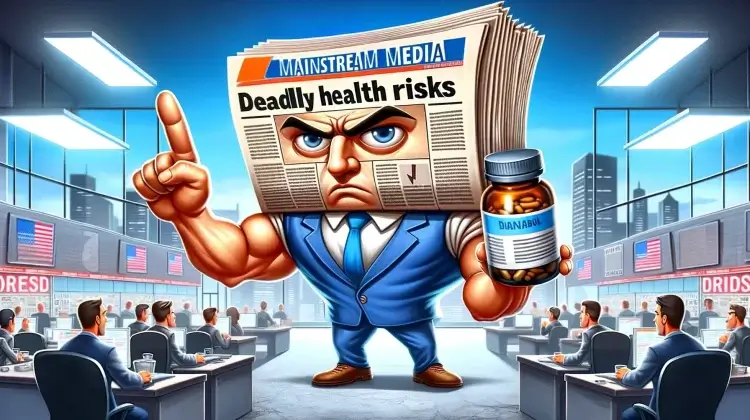
Estimated reading time: 9 minutes
Table of contents
- Introduction
- Lyle Alzado’s Cancer Diagnosis and the Blame Game
- The Media Narrative Linking Alzado’s Steroid Use to His Death
- Alzado’s Evolution from Denial to Admission on ‘First Person with Maria Shriver’
- Lyle Alzado and Agenda Building Theory
- Analyzing the Media’s Shift in Reporting on Anabolic Steroids
- Research Conclusions
- The Role of Agenda Building in the Anti-Doping Movement
- References
Introduction
The Lyle Alzado investigation builds upon Bryan Denham’s 1997 research, which examined the role of Sports Illustrated in shaping the legislative discourse during the Anabolic Steroid Control Act of 1990 hearings. Denham’s earlier analysis highlighted how the magazine’s coverage and its featured personalities played a pivotal role in the reclassification of steroids as Schedule III Controlled Substances, contributing significantly to the development of agenda-building theory.
Denham’s 1999 followup study—“Building the Agenda and Adjusting the Frame: How the Dramatic Revelations of Lyle Alzado Impacted Mainstream Press Coverage of Anabolic Steroid Use”—documents mainstream media’s clear shift from a focus on the legality and policy implications of steroids to a more acute concern with their health risks following Alzado’s revelations.
His research highlights how a powerful personal story from a renowned personality can significantly alter public conversations and reshape media agendas, showcasing a key pathway through which media frames are transformed in response to prominent disclosures.

Lyle Alzado’s Cancer Diagnosis and the Blame Game
Alzado, the former NFL star, and his physician, Dr. Robert Huizenga, attributed Alzado’s devastating cancer diagnosis to his long-term use of steroids, despite the absence of conclusive medical evidence directly linking steroid use to cancer. Dr. Huizenga pointed to Alzado’s extensive steroid consumption, which persisted despite repeated health warnings, as a contributing factor to his brain lymphoma and subsequent death.
In a candid first-person narrative published in Sports Illustrated, Alzado confessed to deceiving others about his steroid use for decades. He admitted to beginning his steroid use in 1969 and continuing unabated, including the use of human growth hormone, up until his diagnosis. Throughout his career, Alzado dismissed numerous cautions about the potential dangers, a decision he regretted as he confronted the reality of his illness.
The Media Narrative Linking Alzado’s Steroid Use to His Death
Following Lyle Alzado’s death in May 1992, the media swiftly embraced his public declaration that his long-term use of anabolic steroids had caused his brain cancer, despite no scientific proof definitively linking the two. Journalists across various publications widely accepted and disseminated the belief that steroids were culpable for his demise.
Prominent outlets like the Chicago Tribune and USA Today often portrayed Alzado’s story as a cautionary tale, emphasizing the potential dangers of steroid misuse and framing him as a victim of his own choices. This narrative dovetailed into broader discussions on drug use in sports, painting a stark picture of the consequences.
The intensity of media coverage was significantly shaped by Alzado’s own dramatic and public recounting of his ordeal on television and in print, which likely reinforced the journalistic narrative that directly linked his steroid use to his illness and subsequent death, even in the absence of conclusive medical evidence.
Alzado’s Evolution from Denial to Admission on ‘First Person with Maria Shriver’
In a poignant exploration of Lyle Alzado’s public struggle with steroid use, two distinct interviews on the television program “First Person with Maria Shriver” and a powerful cover story in Sports Illustrated capture the former NFL player’s dramatic transformation.
In a 1990 appearance on “First Person,” Alzado emphatically denied using performance-enhancing drugs as he discussed his aspirations to rejoin the NFL at 41. He presented a tough, assertive demeanor, embracing the violent nature of American football and dismissing any allegations of steroid use with levity. This interview showcased Alzado’s robust persona, punctuated by anecdotes of his past aggressive behaviors.
The narrative took a profound turn in 1991 when a visibly deteriorated Alzado returned to the show and appeared on the cover of Sports Illustrated. In stark contrast to his previous appearance, he admitted to losing over 60 pounds and struggling with basic mobility, painting a picture of a man deeply altered both physically and mentally. Alzado openly regretted the tough exterior he had once projected, recognizing that it was largely a facade.
During this later appearance, Alzado revealed personal trials, including a recent marriage and a swift hospitalization for brain cancer—a rare form of lymphoma. Contradicting his earlier denial, he confessed to extensive steroid use throughout his 16-year professional career and speculated that it had weakened his immune system, contributing to his illness. He also suggested that his initial denials were driven by fear of repercussions.
Alzado estimated that 75% of his fellow players used performance enhancers and believed that team commissioners and owners, though likely aware, chose to ignore this prevalent issue.
Although no scientific evidence directly linked Alzado’s steroid use to his cancer, his candid admissions transformed him into a symbol of the potential dangers of anabolic steroids. His death shortly thereafter elevated the discussion about performance-enhancing drugs in sports to a national dialogue.

Lyle Alzado and Agenda Building Theory
Denham’s 1997 study scrutinizes the role Sports Illustrated played during the Anabolic Steroid Control Act of 1990 hearings, framed by the agenda building theory—an evolution of the agenda-setting theory posited by McCombs and Shaw in 1972. Agenda-setting originally underscored how media could sculpt public perceptions about the significance of issues, demonstrated during the 1968 presidential campaign.
Denham extends this framework to explore how the magazine’s coverage might have swayed policy-making concerning anabolic steroids. Agenda building theory posits that the media not only spotlights issues but also molds public comprehension and reactions through specific framing. This process, detailed by Lang and Lang in 1983, includes six key steps:
- Selective highlighting of issues and events.
- Modulating coverage intensity to enhance public engagement.
- Framing issues in ways that the public can easily grasp, such as casting anabolic steroids in a negative light concerning legality and health.
- Employing language that nudges public perception, potentially redefining steroid use from a policy mishap to a critical health danger.
- Connecting the discussion to broader, resonant themes like the integrity of sports or the dangers of harmful substances.
- Intensifying the agenda-building process when public figures like Lyle Alzado make dramatic disclosures about the detrimental effects of steroids.
The study further incorporates examples of how high-profile figures can dramatically influence media narratives, citing instances from politics and celebrity incidents that reshaped drug reporting in sports, such as the death of Len Bias.
Analyzing the Media’s Shift in Reporting on Anabolic Steroids
The study’s methodological framework was designed to assess the impact of Lyle Alzado’s public disclosures on the portrayal of anabolic steroids in the media. Data was meticulously compiled from all 1991 records available through Nexis, totaling 621 entries. Of these, 414 articles were deemed substantive enough for detailed content analysis.
Denham utilized a targeted selection process, focusing exclusively on articles with comprehensive discussions on the subject while omitting brief mentions and duplicate syndicated content. The study emphasized the nuanced interplay between various factors—such as mentions of the football star Lyle Alzado, the type of publication, and references to steroid-related health risks—using sophisticated hierarchical log-linear modeling to analyze these variables.
The primary goal of the research was to assess whether Alzado’s candid 1991 admissions about steroid use shifted media narratives from policy enforcement to the broader public health implications. The analysis considered five crucial variables: mentions of Alzado, the type of media, coverage of health risks and policy issues, and the timeframe of articles.
Denham’s methodical approach, starting with an expansive model and refining down to simpler explanations, aimed to pinpoint how different factors interacted within the coverage.

Research Conclusions
Denham’s study investigates the impact of Lyle Alzado’s public revelations on the portrayal of anabolic steroids by mainstream media. It explores how his forthright disclosure redirected the media narrative from focusing primarily on policy to highlighting the health risks associated with steroid use. Here is a detailed breakdown of the key findings:
1. Impact of Alzado’s Revelations
The study demonstrates a significant shift in media coverage following Alzado’s public admissions. Initially, coverage was predominantly policy-oriented, influenced by the Anabolic Steroid Control Act of 1990. Post-disclosure, there was a substantial increase in discussions around the health implications of steroids, with mentions of health risks rising from 26.2% to 51.6%.
2. Agenda Building Theory
The findings lend strong support to agenda building theory, especially the concept that the influence of prominent figures can rapidly accelerate media focus. Alzado’s high profile and his honest account of steroids’ detrimental effects on his health catalyzed this shift in media attention.
3. Media Analysis
The analysis indicates that before Alzado’s disclosures, 89% of articles centered on policy issues. This focus shifted after his revelations, with policy mentions decreasing to 78% while discussions of health risks saw a significant rise.
4. Role of High-Profile Individuals
Figures like Alzado are pivotal in reshaping media agendas. His personal story made the dangers of steroid use a compelling narrative, moving the discussion from abstract policy to concrete health consequences.
5. Media Response and Coverage Trends
Initially, only about one in four articles in the first half of 1991 addressed health risks. This ratio dramatically increased to one in two articles post-revelations, signaling a major shift in journalistic focus and heightened public awareness.
6. Journalistic Practices and Influence
The discussion underscores how journalistic standards and practices influence coverage. Prominent publications like Sports Illustrated played a crucial role in re-framing the steroid debate to emphasize serious health risks, potentially impacting public perceptions and policy deliberations.
7. Impact on Public Perception and Policy
The altered media framing likely influenced public attitudes and behaviors regarding steroid use. Portraying steroids as directly linked to severe health issues like brain cancer reframes the narrative from a legal issue to a grave health concern, impacting policy and public opinion.
8. Long-Term Effects and Scientific Perspective
The study acknowledges the ongoing debate within the scientific community about steroids’ long-term effects. While Alzado’s case was portrayed as a direct consequence of steroid use, experts such as Charles Yesalis advocate for caution, pointing out that the definitive impacts of steroids remain unclear.
The Role of Agenda Building in the Anti-Doping Movement
In summary, Bryan Denham’s research explores the profound influence of the media in shaping public discourse, as illustrated through the lens of agenda building theory. The research demonstrates how television and print media, by presenting assumed links between steroid use and severe health issues as fact, may contribute to public hysteria and influence policy discussions without solid scientific support.
Denham’s analysis highlights the shift from regulatory compliance to sensational health risks, illustrating the profound influence of personal narratives in shaping public perceptions and policy debates on health and safety. Through Alzado’s case, the study underscores the media’s role in swaying public opinion based more on compelling narratives than empirical evidence.
Denham’s pioneering application of the agenda building theory to elucidate how mainstream media has fueled the anti-doping movement’s rise to prominence and its pivotal role in the criminalization of anabolic steroids represents a groundbreaking development in the study of sports policy and media influence.
References
Denham, B. E. (1999). Building the Agenda and Adjusting the Frame: How the Dramatic Revelations of Lyle Alzado Impacted Mainstream Press Coverage of Anabolic Steroid Use. Sociology of Sport Journal, 16(1), 1–15. https://doi.org/10.1123/ssj.16.1.1
Denham, B. E. (1997). Sports Illustrated, “the War on Drugs” and the Anabolic Steroid Control Act of 1990: A Study in Agenda Building and Political Timing. Journal of Sport and Social Issues, 21(3), 260–273. https://doi.org/10.1177/019372397021003003
About the author
Millard writes about anabolic steroids and performance enhancing drugs and their use and impact in sport and society. He discusses the medical and non-medical uses of anabolic-androgenic steroids while advocating a harm reduction approach to steroid education.

Leave a Reply
You must be logged in to post a comment.